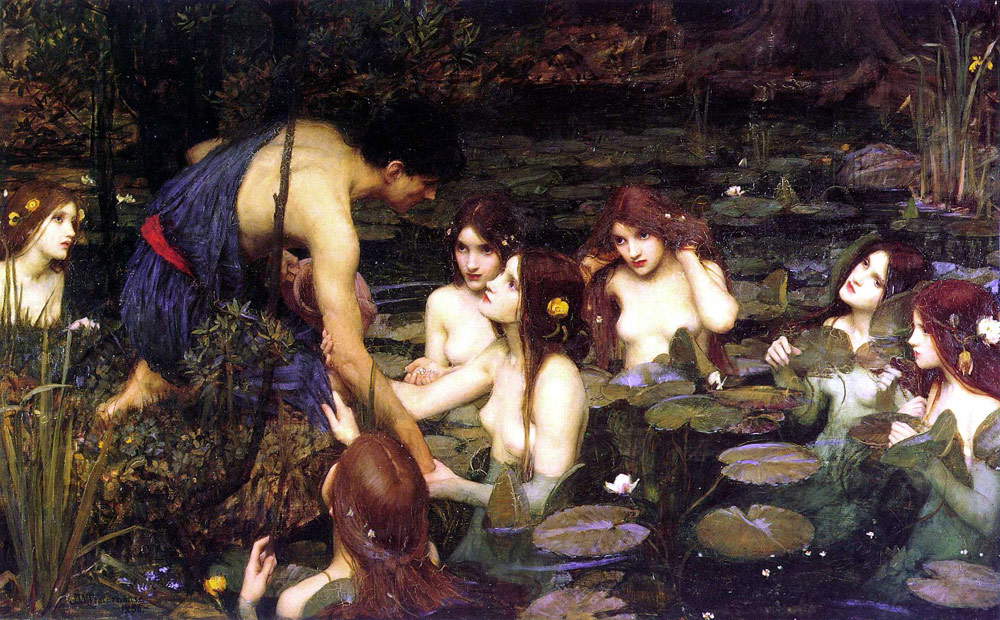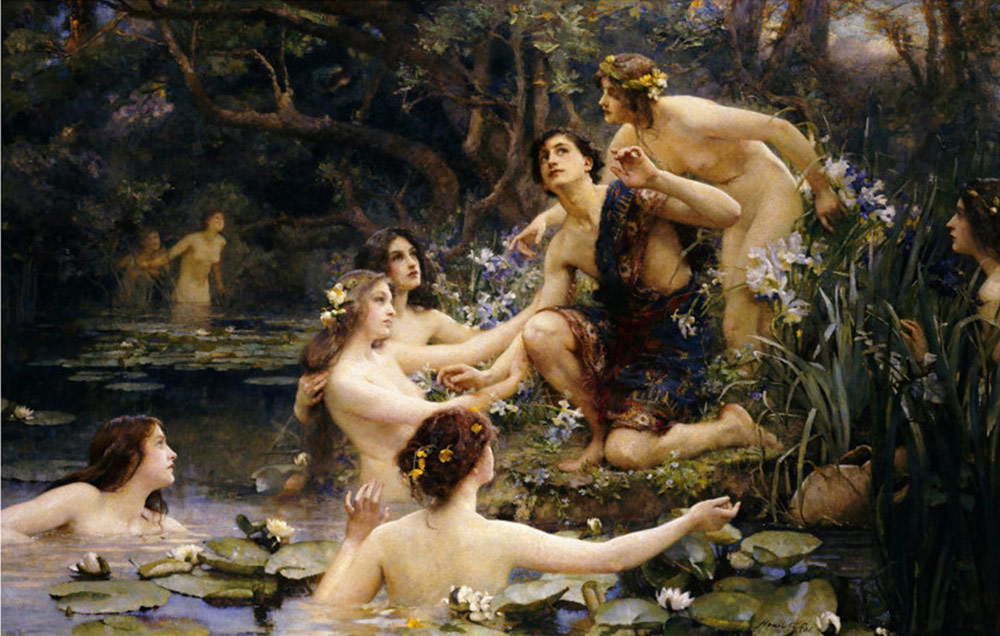If #MeToo turns prudery and gets a 19th-century painting removed from a museum
The news goes back to the end of January: in a major British museum, the Manchester Art Gallery, by decision of director Clare Gannaway, a 19th-century painting by a late Pre-Raphaelite painter, John William Waterhouse (Rome, 1849 - London, 1917), was removed for a week from the room that housed it. The work, created in the lateVictorian era (it dates from 1896, to be exact), depicts the myth of Ila and the nymphs: in the Argonautics of Valerius Flaccus, we read that Ila, one of the members of the Argonauts’ expedition and a squire of Heracles, was kidnapped by the nymphs during a stop on land that became necessary to replenish water supplies. The nymphs became enamored with the Greek hero and would not let him leave again: thus, the ship Argo was forced to set sail without him. Waterhouse depicts the moment when the nymphs drag Ila by the arm to involve him in the bath they are taking in a pond.
 |
| John William Waterhouse, Ila and the Nymphs (1896; oil on canvas, 132.1 x 197.5 cm; Manchester, Manchester Art Gallery) |
In the statement released by the museum following the return ofIla and the Nymphs to its room after its week-long absence, it was stated that the Manchester Art Gallery "left a temporary gallery space in place of John William Waterhouse’sIla and the Nymphs to stimulate discussion about the way works in Manchester’s public collection are shown and interpreted." In fact, visitors could leave a post-it note with their thoughts on the blank wall, and a space for comments was opened on the museum’s website, which can still be used today. The note then offered further food for thought: “This gallery presents the female body both as a ’passive form of decoration’ and in the guise of a ’femme fatale.’ Let us challenge this Victorian fantasy! The gallery continues to exist in a world filled with interrelated issues of gender, race, sexuality, and social class that affect us all. Can art speak in more contemporary and relevant ways? What other stories might the works and their characters tell us? What other themes might we explore in the gallery?” The removal of the painting was then filmed and will become part of the exhibition that artist Sonia Boyce, creator of the action along with Clare Gannaway, will hold at the Manchester museum from March 23 to September 2, 2018. The director, during the days of the painting’s absence from the gallery, also explained to the Guardian that her intent was not to censor, but to spark a discussion, and that recent campaigns such as Time’s Up and #MeToo influenced the choice.
It should be emphasized that a discussion was indeed sparked: but it was certainly not about the representation of the female body in art and the attitude museums should take toward ancient works of art that do not match today’s sensibilities. In fact, the whole world has been questioning the appropriateness of removing a painting from its exhibition context in order to accommodate the reasons of a movement that arose in contemporary times, and which carries forward demands that are obviously more than shareable, but refer to the social and cultural reality of the twenty-first century. In other words: it is legitimate to discuss the commodification of the female body, it is more than fair to censure and prosecute any behavior considered detrimental to the dignity of women, it is correct to prevent the continuation of considering women as objects. What is perhaps neither legitimate, nor just, nor correct is to apply contemporary categories of judgment to a painting executed more than a hundred years ago. Especially since this is neither a painting in which the woman is objectified, nor a work in which the woman is subjected to violence. On the contrary, in this case the opposite is true, since according to the myth it was the nymphs who kidnapped the Argonaut because they fell in love with him: the only fault of Waterhouse’s work seems to be that of giving image to an erotic fantasy that crowds the imagination of a countless number of heterosexual males.
The Manchester Art Gallery’s action must certainly be evaluated in all its aspects. In the meantime, it is necessary to clear the field of misunderstandings and to agree with Clare Gannaway when she affirms that it is not a matter of censorship: however, the director’s most serious mistake was to have created a communication campaign that was decidedly ambiguous and that turned out to be incredibly wrong and counterproductive, since the museum was accused of censorship by the media all over the world. Having then associated the idea with the #MeToo campaign, with the obvious and predictable reactions of sexists and machists everywhere (but also of moderates who misinterpreted the ambitions of the operation), did the rest. The operation can be justified as Sonia Boyce’s performance art, whether one wants to share it or not: it is nothing more than a belated experiment in nouveau réalisme, similar to Christo’s wrappings, and animated by the same principle (which never goes out of fashion and is always working), namely hiding in order to emphasize the importance of an object or topic. Doubts arise when we move from performance to the more mundane museum practice: is it right, then, to remove a work in order to give rise to a debate? Is it correct to want to recontextualize the art of the past on the basis of present sensibilities? In other words: does it make sense to want to “challenge a Victorian fantasy”?
The main problem with the operation, in addition to the serious communication shortcomings that have led most to misrepresent its message (the action carried out by Clare Gannaway and Sonia Boyce is too refined for the mass media and at the same time too prone to possible misunderstandings), is the fact that a very dangerous precedent has been set for those who, having mistaken a desire to debate for a desire to censor, might not have too much trouble in the future in calling for the removal of works of art considered offensive or sexist. It is admittedly true that those who run museums are typically equipped with sufficient reasoning to prevent a transformation of #MeToo into prudery (just enough to deem an unsuspecting late 19th-century Pre-Raphaelite sexist: not the case with the director of the Manchester Art Gallery, who is too smart to have indulged in such considerations, but there are unfortunately precedents) from harming the works on display. However, surprises can always be expected. There have already been cases of museums succumbing to political correctness: the example of the Rijksmuseum in Amsterdam, which in late 2015 began subjecting all of its works to a massive updating of titles deemed offensive, is worth mentioning. An operation that, if not liable to be branded as historical revisionism, nevertheless represents something very similar.
So, what to do? There is only one answer: keep in mind what Roberto Longhi wrote, namely that the work of art is always embedded in a system of relationships, and consequently contextualize. Take Waterhouse’s work: perhaps it would indeed have been appropriate to say that a female artist contemporary with her, namely Henrietta Rae (London, 1859 - 1928) also made a painting depicting Ila and the nymphs. A painting, moreover, far more sensual than Waterhouse’s: Henrietta Rae’s nymphs are individually characterized (as opposed to Waterhouse’s, which all have the same face), the composition is looser, the protagonists are far more involved, and the eroticism is far more palpable. No one, at the time of its creation (the 1910s), would have dreamed of placing the work at the center of a debate: the academic nude was a commonly accepted practice, there were paintings where, in place of female nudes, male nudes certainly no less sensual were depicted, and the body, both male and female, while not failing to tickle the fancies of the viewers (exotic nudes abounded in the homes of the time: and yet there is absolutely nothing wrong with discerning erotic suggestions in a painting), it was also appreciated for its beauty, its harmony, the balance of its proportions. To launch into risky operations, without providing the public with the proper tools for thoughtful reflection, is a failed action right from the start. And the case of Manchester is a prime example of how much damage incomplete or misunderstood communication can do.
 |
| Henrietta Rae, Ila and the Nymphs (1910; oil on canvas, 142.3 x 222.8 cm; Private collection) |
Warning: the translation into English of the original Italian article was created using automatic tools. We undertake to review all articles, but we do not guarantee the total absence of inaccuracies in the translation due to the program. You can find the original by clicking on the ITA button. If you find any mistake,please contact us.




























